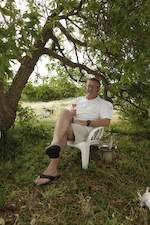The essence of Johan Malan is to be found in the family's solitary little holiday cabin tucked away in a cove at Cape Hangklip on the False Bay coast. The wooden deck of the prefab house set among the indigenous coastal fynbos in a privately owned nature reserve is mere metres from the water's edge.
Vintage 32

Humble and unassuming, it's where mild mannered, quietly spoken Johan retreats for a rare bit of peace and quiet; reading, netting some kreef [crayfish], diving for alikreukel [giant periwinkle], watching the sunset from the wooden deck with a chilled glass of his Simonsig Kaapse Vonkel bubbly.
Not that the Hangklip house hasn't seen some social times, reflecting the other side of this vintner, a kindly host with his customary twinkle in the eye. Overseas guests (friends, winemakers, agents and buyers) have been thrilled by whales in the water, baboons in the bushes and freshly caught kreef on the table.
The cabin is somewhat of a legend among the local winemaking fraternity too: it served as a popular meeting place for Guild family gatherings in the early days. Johan was one of four new members invited to join in 1984, soon after the Guild was founded. It is testimony to the high regard in which this winemaker was already held back then; he had graduated from Stellenbosch University with a B.Sc. in viticulture and oenology just a few years before.
But wine ran through his veins: he had grown up on the grape and fruit farm De Hoop in Stellenbosch, learning at the feet of one of the Cape's most feisty and forward-thinking wine growers and vintners: his father, Frans Malan.
Frans had established the Malan winemaking legacy under the Simonsig name after marrying Liza van Niekerk, whose father Pieter Beyers had planted vines, made wine and practised mixed farming on De Hoop in the 1940s. Frans, M.Sc. graduate in oenology from Stellenbosch University, took over from his father-in-law in 1953. He planted more vineyards, enlarged the cellar, bought a second property and released the first wines under the Simonsig label in 1968.
Simonsig was one of the first five private Stellenbosch cellars to bottle and market its wine independently; a driving force behind the first 'wine route'; the first to make a Cape méthode champenoise sparkling wine; among the first to market a Rhine riesling, a wooded white wine called Vin Fumé, a Chardonnay, and chenin blanc Noble Late Harvest; and blend locally bred pinotage with French noble varieties cabernet sauvignon and merlot which evolved into the Cape-blend style.
Johan recalls the family's traditional Sunday lunches as a child when his father poured each of · is three boys a liqueur glass of wine: the very first wine to stick in his memory was an Uitkyk Carlonet 1958, from another early 'independent' Cape estate then owned by Prussian immigrants' son Georg von Carlowitz at the foot of the Simonsberg mountain.
Johan and his brothers were involved in farming activities from early childhood: picking fruit, driving tractors, learning to fix equipment, and waxing the insides of the old concrete fermentation tanks. Each was to play a role in Simonsig's continuing success. Francois, the middle brother and a B.Sc. graduate with honours in viticulture, is now managing director and in charge of the vineyards. Pieter is the globetrotting eldest brother who set up a network of importers in more than 45 countries. And Johan, the youngest, is the winemaker.
'My father used to say: if you take three canes and bind them together, the result will always be stronger than one on its own. '
The wise and canny Oom Frans gave his sons full responsibility for the farm relatively early on (he was only in his fifties, they in their twenties) but remained fully engaged until his death in 2003 at the age of.75.
Johan recalls his first solo 1983 vintage being 'hell; a baptism of fire'. His father had bought a third property called Morgenster in 1980 and come that momentous year, a record crop flooded into Simonsig's cellar, warranting substantial winery expansions over the next couple of years.
But from the start Johan proved himself more than up to the task. As innovative and inspirational as his feisty father, he nevertheless remained true to his personality. Apparently easy-going, always unassuming, he embraced with quiet confidence everything the redoubtable elder man had established... and finessed it.
Under his steady, consistent and characteristically unhurried and thoughtful guidance the estate's top tier of wines grew in stature and style, becoming richly New World in fruit, traditionally French in elegance. But at the same time, he neither neglected nor dropped the ball on what he has called 'my silent majority'.
As local and international taste trends changed and grew more sophisticated, vineyards were replanted and the range trimmed and adapted. But it was always in a drive to improve quality and in answer to what wine lovers wanted; never intended to earn awards, acclaim or kudos.
 Hangklip crayfish soup recipe with mussels by Johan Malan paired with Simonsig Kaapse Vonkel or Simonsig Cuvée Royale Blanc de Blancs....
Hangklip crayfish soup recipe with mussels by Johan Malan paired with Simonsig Kaapse Vonkel or Simonsig Cuvée Royale Blanc de Blancs.... Pecan nut tart recipe by Johan Malan paired with Simonsig Vin de Liza Noble Late Harvest....
Pecan nut tart recipe by Johan Malan paired with Simonsig Vin de Liza Noble Late Harvest....